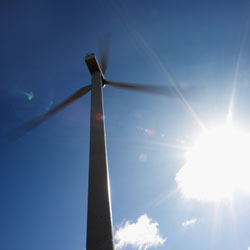 Researchers studying the wake effects on wind turbines at Johns Hopkins University have recently discovered that the output from wind turbines could be greatly increased if wind turbines were spaced at twice the distance than the industry standard.
Researchers studying the wake effects on wind turbines at Johns Hopkins University have recently discovered that the output from wind turbines could be greatly increased if wind turbines were spaced at twice the distance than the industry standard.
Charles Meneveau, a professor and co-author of the study, says that placing wind turbines 15 rotor diameters apart – more than twice as far as current turbine layouts – could result in more cost-efficient power generation.
‘We have been working on better understanding of the coupling of large wind farms with the entire atmospheric boundary layer,’ Meneveau explains. ‘As a result of our computational fluid dynamics in the idealized geometries of the very large wind farm, we developed an improved understanding of the cumulative effects of wakes, coupled with the overall velocity profiles in the entire atmospheric boundary layer. This is an asymptotic limit, which the current models have not explored sufficiently.’
In mathematical analysis, asymptotic analysis is a method of describing limiting behavior.
‘The fact, though, is that when using the asymptotic model to ask about optimal spacing of the very idealized case of the infinite wind farm, the spacing ends up being about twice as large as current values,’ Meneveau notes.
However, he cautions that results are only applicable in the context of very large wind farms in an idealized setting.
‘Earlier computational models for large wind farm layouts were based on simply the adding up of what happens in the wakes of single wind turbines,’ Meneveau says.
The new spacing model, he says, takes into account interaction of arrays of turbines with the entire atmospheric wind flow.
The experiments were conducted in the Johns Hopkins wind tunnel, which uses a large fan to generate a stream of air. Before it enters the testing area, the air passes through an active grid – a curtain of perforated plates that rotate randomly and create turbulence so that the air moving through the tunnel more closely resembles real-life wind conditions.
However, when results of the study were widely released, some resource assessment professionals were skeptical.
‘I thought the study was a bit over-reaching,’ explains Rolf Miller, director of wind assessment at Chicago-based Acciona Windpower. ‘To just focus on spacing and not include all of the other real-world factors, such as working with landowners, electrical line and balance-of-plant costs, trivializes the work that wind resource assessment people do.’
Miller continues, ‘If you just double the rotor diameter, you easily double the cost of the project.’ Using a real-world example, Miller cites the Ontario wind market as but one reason the study is flawed.
‘Ontario – with its feed-in tariff – is hot right now,’ he says. ‘However, using [the Johns Hopkins methodology] methodology you wouldn't be able to build a single wind project in such a fairly populated area. They are trying to shoehorn projects there right now.’
However, Miller says, the study has merits, particularly for the study on work on inter-turbine wake characteristics – how one turbine plays off another in the grid string.
‘There is a lot of work to be done in that area,’ he says.



